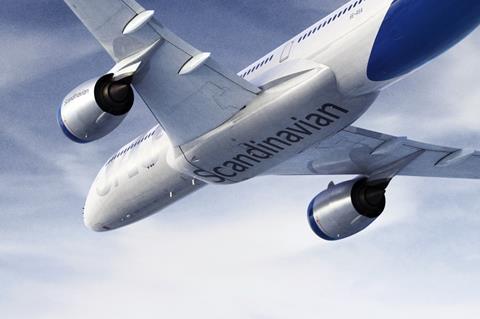Scandinavian carrier SAS has embarked on a planned equity-raising process, the latest stage of its restructuring programme under US Chapter 11 bankruptcy protection.
SAS has previously indicated that it wants to raise at least SKr9.5 billion ($911 million) through the process.
But it points out: “The final amount of equity financing raised will depend upon the competitive equity-raise process along with the company’s ongoing ability to generate additional liquidity.”
SAS is filing a motion with the bankruptcy court seeking approval of the procedures which will govern the process of inviting equity investment in the restructured carrier.
It states that it will seek the “best available” terms for the equity through the competition. The hearing for the solicitation motion is scheduled for 19 April, and SAS expects the process to select a lead investor to take about 12 weeks.
The equity-raise is necessary in order for SAS to pay off its debtor-in-possession loan and meet other obligations. “All or substantially all of the proceeds from the equity raise will be needed to provide SAS with sufficient liquidity to operate,” it states.
SAS’s restructuring programme, known as ‘SAS Forward’, is not only aiming to raise equity but also reduce or convert SKr20 billion in debt.

The company has revised upwards its financial forecast for the business, expecting revenues of up to SKr58 billion for the full year 2025-26, compared with the previous estimate of SKr49 billion.
It is basing this new projection on plans for network optimisation and predictions of higher demand, along with increased cost-savings through agreements with lessors, and a faster capacity rebound from having more long-haul aircraft.
SAS sees a pre-tax earnings margin for 2025-26 of around 9-10% against the earlier figure of 6-8%.
“We are taking the key next step in ‘SAS Forward’, our transformation plan that aims to improve our financial strength, secure long-term competitiveness and fortify our position as Scandinavia’s leading airline,” says chief executive Anko van der Werff.
For the current fiscal year, 2022-23, revenues will exceed SKr40 billion and return to pre-pandemic levels in 2023-24. Liquidity level at the end of 2022-23 will “significantly exceed” the 15% figure outlined in its previous projection, the carrier states.
It still expects to achieve a pre-tax loss of SKr4-5 billion, but points out that a number of cost-efficiency initiatives are only being implemented over 2022-23 or cannot be recognised until the company exits the Chapter 11 process.
SAS expects to reach positive pre-tax earnings in 2023-24, increasing to SKr5-6 billion in 2025-26 once the ‘SAS Forward’ plan has been fully implemented – by which point it aims to be “close to net debt-free”.












































